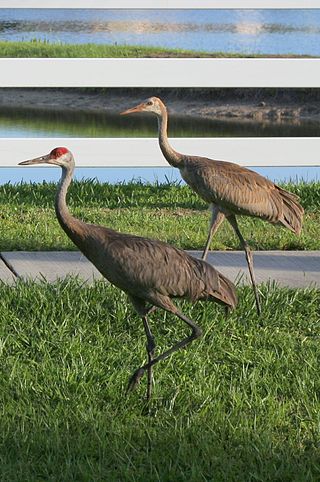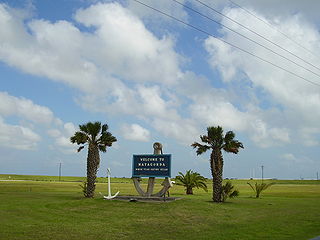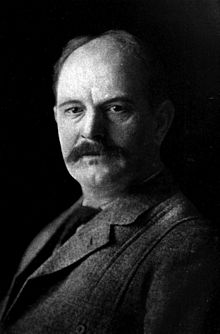
Point Pelee National Park is a national park in Essex County in southwestern Ontario, Canada where it extends into Lake Erie. The word pelée is French for 'bald'. Point Pelee consists of a peninsula of land, mainly of marsh and woodland habitats, that tapers to a sharp point as it extends into Lake Erie. Middle Island, also part of Point Pelee National Park, was acquired in 2000 and is just north of the Canada–United States border in Lake Erie. Point Pelee is the southernmost point of mainland Canada, and is located on a foundation of glacial sand, silt and gravel that bites into Lake Erie. This spit of land is slightly more than seven kilometres long by 4.5 kilometres (2.8 mi) wide at its northern base. Established in 1918, Point Pelee was the first national park in Canada to be established for conservation. It was designated as a Ramsar site on 27 May 1987.

Palacios is a city in Matagorda County, Texas, United States. The population was 4,395 at the 2020 census.

The western marsh harrier is a large harrier, a bird of prey from temperate and subtropical western Eurasia and adjacent Africa. It is also known as the Eurasian marsh harrier. Formerly, a number of relatives were included in C. aeruginosus, which was then known as "marsh harrier". The related taxa are now generally considered to be separate species: the eastern marsh harrier, the Papuan harrier of eastern Asia and the Wallacea, the swamp harrier of Australasia and the Madagascar marsh harrier of the western Indian Ocean islands.

The white-faced ibis is a wading bird in the ibis family, Threskiornithidae.

The British Trust for Ornithology (BTO) is an organisation founded in 1932 for the study of birds in the British Isles. The Prince of Wales has been patron since October 2020.

The sandhill crane is a species of large crane of North America and extreme northeastern Siberia. The common name of this bird refers to habitat like that at the Platte River, on the edge of Nebraska's Sandhills on the American Great Plains. Sandhill Cranes are known to hang out at the edges of bodies of water, especially in the Central Florida region. The central Platte River valley in Nebraska is the most important stopover area for the nominotypical subspecies, the lesser sandhill crane, with up to 450,000 of these birds migrating through annually.

The whooping crane is an endangered crane species, native to North America, named for its “whooping” calls. Along with the sandhill crane, it is one of only two crane species native to North America, and it is also the tallest North American bird species. The whooping crane's lifespan is estimated to be 22-24 years in the wild. After being pushed to the brink of extinction, due to unregulated hunting and loss of habitat, and just 21 wild cranes remaining by 1941, conservation efforts would lead to a partial recovery. The total number of cranes in the surviving migratory population, plus three reintroduced flocks and in-captivity, only slightly exceeds 800 birds as of 2020.

Henslow's sparrow is a passerine bird in the family Passerellidae. It was named by John James Audubon in honor of John Stevens Henslow. It was originally classified in the genus Emberiza and called Henslow's bunting.

The palm warbler is a small songbird of the New World warbler family.

Matagorda Bay is a large Gulf of Mexico bay on the Texas coast, lying in Calhoun and Matagorda counties and located approximately 80 miles (130 km) northeast of Corpus Christi, 143 miles (230 km) east-southeast of San Antonio, 108 miles (174 km) south-southwest of Houston, and 167 miles (269 km) south-southeast of Austin. It is one of seven major estuaries along the Gulf Coast of Texas and serves as the mouth of numerous streams, most notably the Lavaca and Colorado Rivers. The Texas seaport of Port Lavaca is located on the system's northwestern extension of Lavaca Bay. The city of Palacios is found on northeastern extension of Tres Palacios Bay, and Port O'Connor is located on the southwestern tip of the main bay's shore. The ghost town of Indianola, which was a major port before it was destroyed by two hurricanes in the late 19th century, is also found on the bay.
A breeding bird survey monitors the status and trends of bird populations. Data from the survey are an important source for the range maps found in field guides. The North American Breeding Bird Survey is a joint project of the United States Geological Survey (USGS) and the Canadian Wildlife Service. The UK Breeding Bird Survey is administered by the British Trust for Ornithology, the Joint Nature Conservation Committee, and the Royal Society for the Protection of Birds.
The Tucson Bird Count (TBC) is a community-based program that monitors bird populations in and around the Tucson, Arizona, United States metropolitan area. With nearly 1000 sites monitored annually, the Tucson Bird Count is among the largest urban biological monitoring programs in the world.

Harris's sparrow is a large sparrow. Their breeding habitat is the north part of central Canada, making it Canada's only endemic breeding bird. In the winter they migrate to the Great Plains states of the United States, from southern South Dakota to central Texas. The common name of this species commemorates the American amateur ornithologist Edward Harris (1799–1863).
The Australian Bird Count (ABC) was a project of the Royal Australasian Ornithologists Union (RAOU). Following the first and successful Atlas of Australian Birds project, which led to the publication of a book on the distribution of Australian birds in 1984, it was suggested by Ken Rogers that the RAOU should next look at bird migration and other movements in Australia. Methodology for a suitable project involving volunteers was worked out through experimental fieldwork and a workshop on ‘Monitoring the Populations and Movements of Australian Birds’.

Matagorda is a census-designated place in Matagorda County, Texas, United States. It is located near the mouth of the Colorado River on the upper Texas coast in the United States. In 2020, its population was 313. Matagorda is primarily a tourist town, with commercial and recreational fishing being the top industries. Approximately 23 miles (37 km) of the beach are accessible by vehicle and 35 additional miles are accessible only by boat. Matagorda is at the end of State Highway 60 and the beginning of Farm to Market Road 2031, which runs over the Intracoastal Waterway and south to the Gulf of Mexico.

The crested caracara, also known as the Mexican eagle, is a bird of prey in the family Falconidae. It is found throughout Central and South America but has been found in northern Minnesota to Tierra del Fuego. It was formerly placed in the genus Polyborus.

The EBCC Atlas of European Breeding Birds - Their Distribution and Abundance (ISBN 0-85661-091-7) is an ornithological atlas published for the European Bird Census Council by T & A D Poyser in 1997. Its editors were Ward J. M. Hagemeijer and Michael J. Blair. The atlas was the first to present grid-square distribution maps for all breeding birds at a Europe-wide level. The bulk of the book is in English, although it also contains introductions in thirteen other European languages. The atlas presents the results of the European Bird Census Council's European Ornithological Atlas project, the fieldwork for which was carried out between 1985 and 1988.

The Quill Lakes is a wetland complex in Saskatchewan, Canada that encompasses the endorheic basin of three distinct lake wetlands: Big Quill Lake, Middle Quill Lake, and Little Quill Lake. On May 27, 1987, it was designated a wetland of international importance via the Ramsar Convention. It was the first Canadian site in the North American Waterfowl Management Plan, is a site in the International Biological Programme and Saskatchewan Heritage Marsh Program, and was designated a Western Hemisphere Shorebird Reserve Network site of International significance in May, 1994. The site is an important staging and breeding area for spring and fall migration of shorebirds. The site qualifies as an Important Bird Area (IBA) of Canada for its globally and nationally significant migratory and breeding populations of more than a dozen species of birds. The IBA is designated as Quill Lakes .

Tres Palacios Bay is a northeastern extension of Matagorda Bay on the Texas coast in Matagorda County. It is fed by the Tres Palacios River. The city of Palacios is located on its shores. A channel that connects Palacios to the Intracoastal Waterway has been dredged through the bay.
















